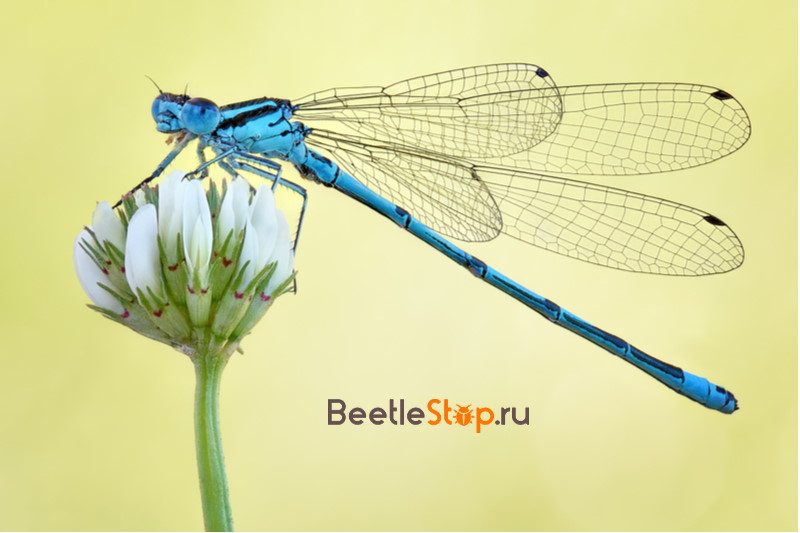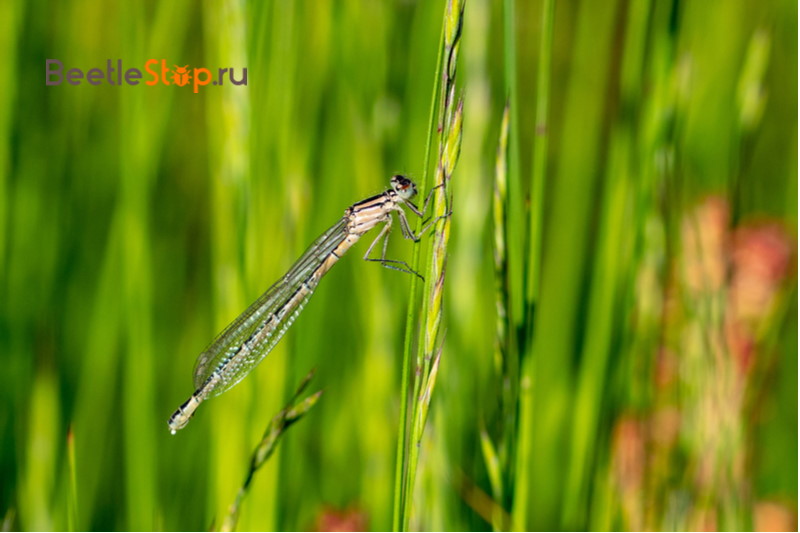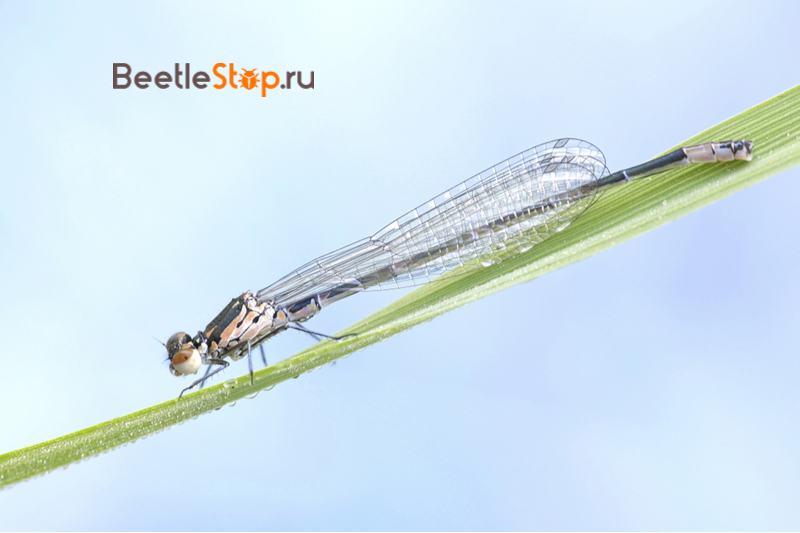Dragonfly arrow beautiful and other species of the arrow family
The arrow family is a small dragonfly with a graceful body and a thin long abdomen. They are found on all continents except Antarctica. Most often, insects are painted in a combination of blue and black. In Russia, you can find several species of the family: dragonfly arrow is beautiful, arrow is blue, arrow is elegant. They are characterized by an interesting way of laying eggs. To place the masonry on the underwater parts of the plants, the females dive into the water, dragging their partners along.

Morphological description of species
Arrows (Coenagrionidae) are small dragonflies from the suborder uniform-winged. Species belonging to the genus true arrows are strikingly similar to each other. It is difficult for an insect lover to distinguish between insects, and professionals are guided by the pattern of black spots on the abdomen. Characteristic features of the genus Coenagrion:
- Representatives of the genus real arrows are distinguished by two specks on the back of the head to match the color.
- Triangular pronotum.
- Transparent, unshaded gill plates of larvae.
- During the rest, the dragonflies fold their wings over the body.
- Sexual dimorphism in the color of insects.
Common species
Dragonfly arrow beautiful (Coenagrion scitulum) lives in natural and artificial ponds with stagnant water. Body length 30-33 mm. Above the abdomen of males is black, with a small interspersed blue. The last segment is completely blue. In females, all segments of the abdomen are bicolor - black with green. The species lives in Western Europe, the Caspian Sea, Central Asia, northern Africa, and Crimea. The female leaves masonry not only in the tissues of plants, but also in sunken trees. Dragonflies leave offspring in bodies of water with a slow course and rich vegetation.
Dragonfly arrow girl (Coenagrion puella) flies from May to September. It lives in the temperate zone of Europe, in the north of Africa, in the south of Siberia. Places of settlement - any lakes, ponds, streams and rivers. Insects can often be found sitting by the water. Males are almost completely blue, females are greenish, individuals are bluish-gray. Black spots on the green abdomen of females look like dark patches with an emerald fringing. Body length 33-35 mm, hind wing 22-32 mm. In cold years, the number of insects decreases due to the death of larvae in freezing water bodies. the population is rapidly recovering.

Arrows blue dragonfly (Enallagma cyathigerum) refers to the genus Enallagma or synestrel. It is also called the cubiferous and enallagma blue meshes. The epithet "cubic" is associated with the pattern in the form of a cup on the second segment of the abdomen of a dragonfly. The head is wide, two bright spots stand out on the black nape. Large eyes are wide apart on the sides of the head. The end of the prothorax is rounded. Wings are transparent with complex venation and monophonic pterostigmus. The legs are dark.

The males are blue with a black pattern. Females are found in various colors: red-brown, greenish, brown. Females in the seventh segment of the abdomen have a spike. The length of adult dragonflies is 33-36 mm, wingspan 40-42 mm. The blue arrow has a wide distribution range: Europe, North Africa, Siberia and the Far East, North America and Asia. Dragonfly years from May to September.They are found in deep clean reservoirs with clean water and plentiful vegetation.
Arrow dragonfly armed (Coenagrion armatum) the warlike name of the species is associated with large, protruding appendages of the male. Dragonfly is found in Northern and Eastern Europe, Siberia, the Far East, and Mongolia. Due to the loss of natural habitats, the arrow began to disappear in Europe. Insects are listed in the IUCN Red List. Body length 29-32 mm, wingspan 40 mm. The width of the head is twice as long as the antennae are weak. The occipital spots are wedge-shaped. Males are blue with black spots on the abdomen, females are greenish-yellow. Dragonflies lay eggs on narrow-leaved plants such as horsetail. The female dips only the tip of the abdomen with the ovipositor into the water.

Arrow dragonfly elegant (Coenagrion pulchellum), pretty or pretty, has a long thin abdomen with a predominant black color. They are found throughout Europe, Central Asia, the Caucasus and southern Siberia. Body length 34-35 mm, wingspan up to 44 mm. In males, the abdomen is black, matte, the front of the segments is blue. The tip of the abdomen is completely blue, only the anal appendages stand out. The color of the females is variable, the abdomen is always two-tone - black with green or blue.

Lifestyle and offspring development
Insects settle on the banks of slow rivers, large streams and lakes. Most flies in May-July; some species are found until the end of summer. All homoptera fly slowly, do not move away from the vegetation. This does not prevent them from being excellent hunters for mosquitoes, flies, bugs and butterflies. After the mating season, the female lays eggs on the underwater part of the plants. She has to lower her belly into the water or dive completely. Eggs are laid on reeds, cattails, sedges, piercing tissue with an ovipositor.
Larvae appear in the spring, stay at the bottom among plants. They have a slender body, a wide head and large eyes. Yellow-green or light brown color often with a vague pattern allows them to merge with the vegetation. The overgrown lower lip forms a mask that extends to grab prey. They feed on daphnia, larvae of mayflies and mosquitoes. Waiting for the victim on aquatic plants. On the tail of the larvae there are three wide gill plates. Breathing occurs with oxygen dissolved in water. The adult larva will grow to 22-25 mm.
Interesting fact. When attacked by a predator, the larva sacrifices one of the gill plates on the tail. The organ is capable of regeneration.
As with other dragonflies, the development of the shooter ends on land, when the larva sheds its hide before leaving an adult.

